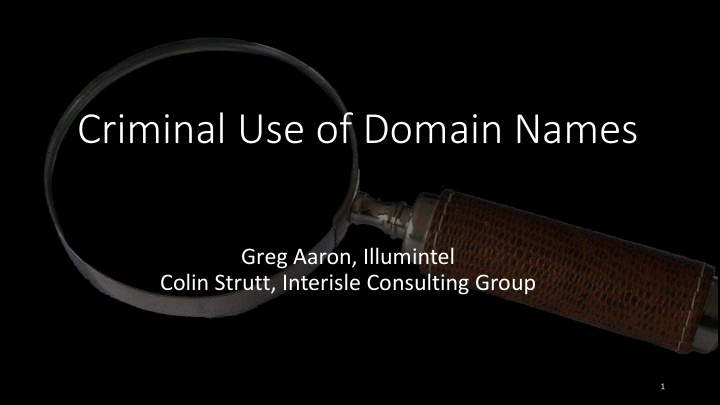



Criminal Use of Domain Names Greg Aaron, Illumintel Colin Strutt, Interisle Consulting Group 1
Maliciously Registered Domain Names • Domain names registered to perpetrate cybercrime. • Scope of the problem? • 197,876,195 gTLD domain names in zone files. • Over the course of a year, about 6 million gTLD domains appear on major blocklists. And that 3% is the floor . • Harms: cybercrime impacts reliability and trust on the Internet. More specifically, it has very human costs: theft of money and personal information. • “harm” vs. “crime” vs. “abuse” • Here’s an example of what you can do with data… 2
Study: “Criminal Abuse of Domain Names: Bulk Registration and Contact Information Access” by Dave Piscitello and Dr. Colin Strutt Interisle Consulting Group http://interisle.net/criminaldomainabuse.html 3
Hypothesis • Cybercriminals take advantage of bulk registration services to “weaponize” large numbers of domains for their attacks. • Bad domains get recognized and blocked • Some criminals need to rapidly, cheaply, and repeatedly acquire domain names 4
Methodology • Assembled composite blocklist and reputation data from a variety of threat intelligence and reputation lists. • Including APWG, SURBL, Spamhaus, Abuse.CH • Indicate a variety of criminal activities, including malware, phishing, spamming • Found where thousands of such domains were blocklisted in short time frames. Selected batches in five TLDs. • Documented when those domains were registered, and at what registrars. This required domain registration data (WHOIS). Studied the registrars with these high concentrations of blocklisted • domains. Did they offer domains cheaply and in bulk? • Studied the behaviors of the registrants who made those bulk registrations. 5
Example: Blocklisted domains in .TOKYO • Blocklisted in .TOKYO from Registrar IANA ID Abuse Domains December 12-25, 2018 = GMO Internet, Inc. 49 8,713 (100%) d/b/a Onamae.com • 8,715 blocklisted domain 1068 2 (0%) NameCheap, Inc. names Nearly all of these were registered using a single registrar 6
Blocklistings corresponded with spike in registrations Above: # of domains in .TOKYO registry. Source: ntldstats.com The blocklisted domains represented 7% of the domains in the TLD 7
Most of the blocklistings occurred on Dec 17, 2018 8
Web site will create Customers random can upload names a file of 1 ¥ = names €0.0083 Why this registrar, GMO? - Very cheap domain registrations - Offers tools to register in volume 9 - Customers can generate random domain strings
Finding Criminal Actors and Assets: Search • SEARCH historical WHOIS records for registrant Name, registrant Street Address, registrant Email address. • Suspect provided a registrant address in Japan • Also registered domains in .INFO, .CLUB, .ONLINE, .XYZ, .BIZ, .SPACE, and .WORK • Assume that criminals submit inaccurate/fraudulent contact data • Only some WHOIS records contain contact data (post-GDPR) • PIVOT to other databases or social media to identify related records and the criminal actors. 10
Finding Criminal Actors and Assets: Pivot • Triangulate against additional data sources: IP address data, passive DNS records (nameservers), malware data, spamples, etc. Each is a different specialty. • Suspect hosted phishing sites and malware, at three hosting providers: InterQ GMO Internet, Inc.; IDC Frontier, Inc.; Sakura Internet, Inc. • Heatmap of phishing and malware activity at INTERQ GMO, AS 7506: • Examining what’s on that hosting often leads to yet more domains, additional bogus pseudonyms, etc. • Conclusion: Japanese criminals, using Japanese registrar, Japanese IP space, 11 targeting Japanese citizens.
General Findings • Study confirms the hypothesis that cybercriminals take advantage of bulk registration services to use large numbers of domains for their attacks • The findings corroborate those of others (2017 ICANN report Statistical Analysis of DNS Abuse in gTLDs (SADAG) • [Disparate data sources are necessary.] • [This is where you can stop play whack-a-mole and where you can make a difference with one intervention.] 12
Recommendations • The report offers nine recommendations. • Some could become binding policy through ICANN. • Others could be implemented by registrars and registry operators themselves. • Others are requests to make better data available. • http://interisle.net/criminaldomainabuse.html 13
Recommend
More recommend